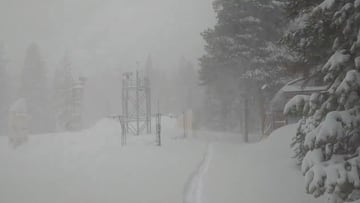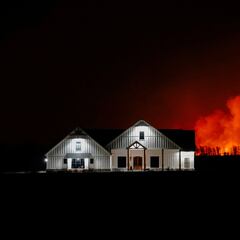What are the biggest blizzards to ever hit the US?
A severe snowstorm is expected to hit Sierra Nevada, bringing with 10 feet of snow and high winds. What are the biggest blizzards to hit the United States?

California and Nevada have been hammered by severe snowstorms which has left parts of both states under several feet of snow. Snow is expected to exceed a depth of 10 feet along the crest of Sierra Nevada and surrounding communities. California authorities shut down 100 miles of Interstate 80 in both directions at the state border near Reno on Friday and urged the public to hunker down, take shelter and if possible, stay off the roads. Whiteout conditions will continue through the weekend with visibility reduced to 1,300 feet (440 yards).
A strong, cold winter storm will bring heavy additional mountain snow and blizzard conditions through the Weekend. Additional multiple FEET of snow are forecast. Expect dangerous travel with excessive delays, whiteout conditions at times, and road closures. #cawx pic.twitter.com/6nWk4MgtHA
— NWS Sacramento (@NWSSacramento) March 1, 2024
Let’s take a look at some of the worst blizzards on record to have hit the United States through the years.
The Great Blizzard of 1888
Also known as the Great White Hurricane, this storm carried with it some 40 to 50 inches of snow, immobilizing New York, New Jersey, Connecticut, and Massachusetts. It claimed the lives of 400 people, the highest death count in US history for a winter storm.
The Knickerbocker Storm of 1922
The storm, so-called because it caused the collapse of the roof of the Knickerbocker Theater in Washington, DC, brought 28 inches of snow and killed 98 people during the intermission of a silent film.
Shot of the South Yard, behind the Smithsonian Institution Building, in the aftermath of the Knickerbocker Storm in 1922. (❄️:MAH-14914) https://t.co/nj5rfWiQP6 pic.twitter.com/m1HzmWkZYq
— Smithsonian Archives (@SmithsonianArch) January 28, 2020
The Great Appalachian Storm of 1950
This blizzard hit the central Appalachians with more than 50 inches of snow over Thanksgiving weekend, and claimed over 160 lives.
The Chicago Blizzard of 1967
The city recorded its highest snowfall in history with the coming of this storm, which blew in 23 inches of snow. The blizzard caused the deaths of 60 people.
FROM THE WGN ARCHIVES
— WGNTV (@WGNTV) January 26, 2022
On this day in 1967, it started snowing in #Chicago and didn't stop until the next day and 23 inches had fallen. Henceforth, the storm came to be known as the Blizzard of '67. Check out this raw video from the @WGNNews archives. #weather #history 🥶 pic.twitter.com/KCdKFSpvC9
The Northeastern Winter Storm of 1978
A devastating nor’easter buried cars and trapped people in their homes and offices in Massachusetts and Rhode Island, and flooded homes on the Long Island Sound and Cape Cod Bay. The death toll was estimated at 100 people.
The Storm of the Century, 1993
A massive blizzard pummeled the East Coast, from Maine to Florida, as well as most parts of eastern Canada. Tornadoes and flooding affected 120 million people and 26 states. It caused 300 deaths and $6 to 10 billion in damages.
Do you recall the infamous Blizzard of '93? Here's a look back at what's been deemed the 'Storm of the Century.' https://t.co/1t0AUjdztz
— WLOS (@WLOS_13) December 10, 2022
STAY TUNED: News 13's "Weathering the Winter" special will be airing this Sunday at 5:30 pm!
The Blizzard of 1996
Three days of snow and sleet struck a large part of the East Coast, killing 150 people. The storm dumped up to 30 inches of snow on cities in the affected area, causing some $3 billion in damages.
The Great Blizzard of 2003
The storm unloaded several feet of snow on the East Coast, causing 20 deaths. Parts of Maryland saw more than three feet, while sections of New York were buried in two.
Snowmageddon in Washington DC, 2010
Three blizzards swept through various parts of the U.S. within 20 days, the first traveling from coast to coast and bringing huge amounts of snow. The second dumped 18 inches of snow on Washington DC, while the third caused blackouts affecting hundreds of thousands of people.
Winter Storm 'Elliott'
— Amherst Police NY 🚔 (@amherstpoliceny) December 26, 2022
12/25/2022
[Photo Credit: Officer Caito] pic.twitter.com/8js2mUBQWr
Winter Storm Jonas of 2016
The storm, also known as Snowzilla, released 15 to 30 inches of snow on the Northeast and mid-Atlantic and caused 19 deaths.
Winter storm 2022
Over the Christmas period, between 21 to 26 December, an extratropical cyclone storm devastated most the of the United States and Canada, causing power outages for more than one million people. Temperatures in some parts of the country plummeted to -70F with the death toll exceeding 100 - almost half of that figure in Buffalo. “This is not like a snow day, when you were a kid, this is serious stuff,” President Joe Biden said in a White House briefing.
Related stories
The Christmas 2002 storm was unofficially named Storm Elliott. During the storm, 1,702 individual Bulk Electric System (BES3) generating units in the Eastern Interconnection experienced 3,565 unplanned outages, derates, or failured to start. It was the fifth case in the past 11 years that the national grid was affected or comprised by bad weather.
More than 4.5 million people in Texas lost power in their homes, and some went without power for as long as four days, while being exposed to below freezing temperatures for as long as six days. The crippling weather conditions caused deaths from hypothermia, carbon monoxide poisoning and medical conditions exacerbated by sub-zero temperatures.


Complete your personal details to comment